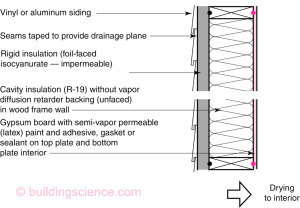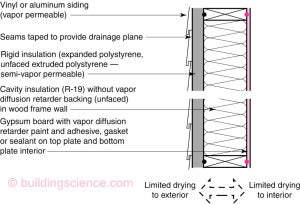As they are typically used in buildings today, vapor barriers are a cold climate artifact that has migrated into other climates more from ignorance than need. However, they often prevent assemblies from drying. Vapor barriers installed on the interior of assemblies prevent assemblies from drying inward. This can be a problem in any air-conditioned enclosure. This can be a problem in any below grade space. This can be a problem where brick is installed over building paper and vapor permeable sheathing. This can be a problem when there is also a vapor barrier on the exterior. Also common is unintentional use of vapor barriers through the application of semi-impermeable finishes such as vinyl wall covering. Even cabinets, fixtures, mirrors, or picture frames can act as unwanted vapor barriers when placed against exterior walls.
Proper vapor control in assemblies is primarily a design responsibility. The viable strategies are informed by climate, exposure, cladding type, structure material, and also by an understanding of the intended occupancy and operation of the building. Consult the resources listed below for further discussion of vapor control in building assemblies.
What is fundamental to robust assemblies is that they have the ability to dry if they become wet. It is often said the buildings or walls need to “breathe.” Actually, it is more correct to say that assemblies need to be able to dry.
Perhaps it goes without saying that moisture problems can be caused during the construction phase if water sensitive materials are allowed to become wet. Problems can also be caused if wet materials are enclosed by vapor retarder or vapor barrier materials before being allowed to dry (e.g. finishes applied over damp-spray insulation before it is dry, finishes applied over concrete that has not released sufficient construction moisture.
Using substitute materials having lower vapor permeance than those originally specified in an assembly may also lead to moisture problems in the near- or long-term, as these less permeable materials will inhibit drying of the assembly. Extreme care must be exercised not to substitute enclosure assembly materials with materials that are less vapor permeable. It is also critical not to install specified vapor retarders or vapor barriers over assemblies before these have had an opportunity to dry. Finally it is important to avoid the application of materials that will act as vapor retarders in locations where a vapor retarder is not specified.
The following table offers a general classification system for permeability of materials as well as the IRC vapor retarder classification. It is always recommended to consult manufacturer product data in order to permit a more precise comparison of material properties.
Vapor impermeable: 0.1 perm or less
Class I vapor retarder
Vapor semi-impermeable: 1.0 perm or less and greater than 0.1 perm
Class II vapor retarder
Vapor semi-permeable: 10 perms or less and greater than 1.0 perm
Class III vapor retarder
Vapor permeable: greater than 10 perms
Some sources will provide vapor permeability in terms of “wet cup” and “dry cup” conditions. Some materials (such as paints or wood products) become more permeable at higher relative humidity conditions; plastic materials (such as housewraps and foams) typically do not see this effect. “Wet cup” tests give material behavior at high humidity, while “dry cup” provide it for low humidity.
Vapor Open Assemblies Details
Figure 1
Example Wall Assemblies and Drying Direction
- Impermeable insulating sheathing prevents drying to the exterior. Gypsum board with latex paint allows drying to the interior.
Figure 2
Example Wall Assemblies and Drying Direction
- Semi-vapor permeable (unfaced) insulating sheathing allows limited drying to the exterior. Vapor diffusion retarder paint on the interior gypsum board limits but does not eliminate drying to the interior.


